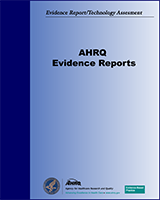NCBI Bookshelf. A service of the National Library of Medicine, National Institutes of Health.
Jadad AR, Boyle M, Cunningham C, et al. Treatment of Attention-Deficit/Hyperactivity Disorder. Rockville (MD): Agency for Healthcare Research and Quality (US); 1999 Nov. (Evidence Reports/Technology Assessments, No. 11.)
This publication is provided for historical reference only and the information may be out of date.
Evidence Tables A: General Characteristics of All Studies
Evidence Table A1. Where Study Was First Identified
Evidence Table A2. Type of Study
Evidence Table A3. Funding Source (multiple answers possible)
Evidence Table A4. Publication Year
Evidence Table A5. Country of Publication
Evidence Table A6. Number of Authors
Evidence Table A7. Areas Covered (multiple areas possible)
Evidence Table A8. Background of First Author (multiple backgrounds possible)
Evidence Table A9. Number of Research Centers
Evidence Table A10. (Study Duration)
Evidence Table A11. Ethnic Groups
Evidence Table A12. Treatment Setting (more than one setting possible)
Evidence Table A13. Is the Analysis Grouped by Treatment Setting?
Evidence Table A14. Are the Inclusion Criteria Reported?
Evidence Table A15. Are the Exclusion Criteria Reported?
Evidence Table A16. Is the Primary Outcome Stated?
Evidence Table A17. Age of Subjects (more than one age group possible)
Evidence Table A18. Gender of Subjects (more than one gender choice possible)
Evidence Table A19. IQ Considered
Evidence Table A20. Diagnostic Model Used
Evidence Table A21. Comorbid Disorders of Subjects (more than one choice possible)
Evidence Table A22. Who Made the Diagnosis? (more than one choice possible)
Evidence Table A23. Sample Origin (more than one choice possible)
Evidence Table A24. Family Characteristics
Evidence Table A25. Number of Treatment Arms
Evidence Table A26. Monitoring of Treatments
Evidence Table A27. Was Compliance With Treatment Measured?
Evidence Table A28. Scores and Tests
Evidence Table A29. Treatment Described
Evidence Table A30. Is the Intended Allocation to Treatment Group Concealed From the Investigator?
Evidence Table A31. Industry Association
Evidence Table A32. Overall Frequencies of Interventions
Evidence Table A33. Overall Outcomes
Evidence Table A34. Overall Frequencies of Tests
Evidence Table B1. Key Characteristics of Studies With Drug vs. Drug Comparisons
Evidence Table B2. Total Number of Characteristics Checked for Drug vs. Drug Comparisons1
Evidence Table B3. Description of Characteristics Checked for Drug vs. Drug Comparisons
Evidence Table C1. Key Characteristics of Studies with Drug vs. Nondrug Comparisons
Evidence Table C2. Total Number of Characteristics Checked for Drug vs. Nondrug Comparisons1
Evidence Table C3. Description of Characteristics Checked for Drug vs. Nondrug Comparisons
Evidence Table D1. Key Characteristics of Studies with Combination Therapy
Evidence Table D2. Total Number of Characteristics Checked for Combination Therapy Comparisons1
Evidence Table D3. Description of Characteristics Checked for Combination Therapy Comparisons
Evidence Table E1. Key Characteristics of Studies Comparing Tricyclic Antidepressants vs. Placebo
Evidence Table F1. Key Characteristics of Studies With Long-term Therapy
Evidence Table F2. Total Number of Characteristics Checked for Studies Evaluating Long-term Therapy1
Evidence Table F3. Description of Characteristics Checked for Studies Evaluating Long-term Therapy
Evidence Table G1. Key Characteristics of Studies in Adults
Evidence Table G2. Total Number of Characteristics Checked for Studies in Adults1
Evidence Table G3. Description of Characteristics Checked for Studies in Adults
Evidence Table H1a. Key Characteristics of Studies with Adverse Effects Focusing on Sleep Disorders
Evidence Table H1b. Key Characteristics of Studies with Adverse Effects Focusing on Headaches
Evidence Table H1c. Key Characteristics of Studies with Adverse Effects Focusing on Motor Tics
Evidence Table H1e. Key Characteristics of Studies with Adverse Effects Focusing on Abdominal Pain
Evidence Table H1f. Key Characteristics of Studies with Adverse Effects Focusing on Irritability
Evidence Table H1g. Key Characteristics of Studies with Adverse Effects Focusing on Nausea
Evidence Table H2. Total Number of Characteristics Checked for Studies with Adverse Effects1
Evidence Table H3. Total Number of Characteristics Checked for Studies with Adverse Effects
Evidence Table I1. Key Characteristics of Studies with Stimulant vs. Placebo Comparisons
Evidence Table I2. Total Number of Characteristics Checked for Studies Involving MPH vs. Placebo1
Evidence Table I3. Description of Characteristics Checked for Studies Involving MPH vs. Placebo
- Evidence Tables - Treatment of Attention-Deficit/Hyperactivity DisorderEvidence Tables - Treatment of Attention-Deficit/Hyperactivity Disorder
- Appendix E. Screening Sheets and Data Extraction Forms - Diagnosis and Treatment...Appendix E. Screening Sheets and Data Extraction Forms - Diagnosis and Treatment of Parkinson's Disease
- Summary - Defining and Managing Chronic Fatigue SyndromeSummary - Defining and Managing Chronic Fatigue Syndrome
- Methodology - Defining and Managing Chronic Fatigue SyndromeMethodology - Defining and Managing Chronic Fatigue Syndrome
- Methods - Diagnosis and Treatment of Acute Bacterial RhinosinusitisMethods - Diagnosis and Treatment of Acute Bacterial Rhinosinusitis
Your browsing activity is empty.
Activity recording is turned off.
See more...
